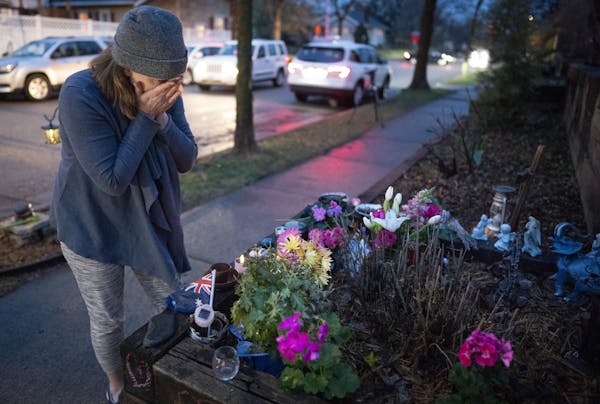Mohamed Noor became the first former Minnesota police officer found guilty of an on-duty murder Tuesday as a Hennepin County jury convicted him for the fatal shooting of Justine Ruszczyk Damond in 2017.
Jurors reached their verdict after about 10 hours of sequestered deliberations in a case that was closely watched nationwide and in Damond's native Australia. They convicted Noor of third-degree murder and second-degree manslaughter but acquitted him of the most serious count — second-degree murder.
Noor, 33, sat expressionless with his hands clasped in front of him as the verdict was read in court just before 5 p.m. One juror hung his head while others sat calmly.
Noor stood from his attorneys' table, was handcuffed and taken into custody after jurors were dismissed, leaving without looking at his family in the gallery, his shackled wrists brushing against the back of his dark-colored suit. He will remain in custody until his sentencing, scheduled for June 7.
Damond's fiancé, Don Damond, dabbed a tissue to his eyes as the verdict was read. He and Damond's father, John Ruszczyk, later joined Hennepin County Attorney Mike Freeman for a news conference in which Don Damond castigated police for his fiancée's death and the initial handling of the investigation.
"Ironically, the Minneapolis Police Department emblem on the squad door reads, 'To protect with courage and to serve with compassion,' " Don Damond said. "… But that night there was a tragic lapse of care and complete disregard for the sanctity of life. The evidence in this case clearly shows an egregious failure of the Minneapolis Police Department."
John Ruszczyk accused some Minneapolis police of "active resistance" to the investigation and said Minnesota Bureau of Criminal Apprehension investigators showed "gross incompetence."
The jury of two women and 10 men began their deliberations Monday afternoon after three weeks of contentious and conflicting testimony and hundreds of pieces of evidence including graphic police body-camera footage of the shooting's aftermath in a south Minneapolis alley.
Noor and his partner, Matthew Harrity, were responding to Damond's 911 call on July 15, 2017, about a possible sexual assault in the alley behind her home when Noor fired from the passenger seat and through Harrity's open driver's-side window. Damond was struck in the abdomen and died at the scene.
Prosecutors argued at trial that Noor violated his training and national police standards when he shot Damond instead of identifying her first and addressing her verbally. Defense attorneys said Noor relied on common police training to eliminate a threat when she appeared next to his squad car in the middle of the night and raised her arm in a fashion that he interpreted as an ambush.
Don Damond and John Ruszczyk urged Minneapolis leaders to continue implementing systemic change to the department.
"I implore Minneapolis Mayor Jacob Frey and Police Chief Medaria Arradondo to do everything they can to ensure these essential human values are not just words on a car door," Don Damond said, "but are lived values of every person in a police department who need a complete transformation of policing in Minneapolis and around the country."
Both men, along with Justine Damond's brother, sister-in-law and stepmother, were fixtures throughout the trial, sitting in the front row of the public gallery next to Noor's wife and parents.
"The jury's decision reflects the community's commitment to three important pillars of a civil society: the rule of law, the respect for the sanctity of life and the obligation of the police force to serve and protect," John Ruszczyk said. "We believe this guilty verdict strengthens those pillars. We hope this will be a catalyst for further change."
Neither family reacted overtly to the verdict, although Damond's sister-in-law hugged Don Damond as jurors were polled individually. Noor's mother and wife leaned forward in their chairs in anticipation through the proceeding.
Noor's attorneys and family left without comment. Before the verdict, his father, Mohamed Abass, didn't appear hopeful.
"We're Muslims," he said. "We will accept any outcome."
Noor's cousin, Goth Ali, who attended the trial every day, broke down after hearing the verdict.
"I'm crying because of how the case was handled," the 32-year-old said afterward. "What happened was injustice. This is shocking. My cousin didn't get a fair trial."
Noor, who was fired from the department after the shooting, is the second officer in recent Minnesota history to be charged with an on-duty fatal shooting. St. Anthony police officer Jeronimo Yanez was acquitted in 2017 in the fatal shooting of Philando Castile during a 2016 traffic stop.
The prosecution's sprawling case against Noor raised alarming questions about Minneapolis police conduct and the BCA. Assistant Hennepin County attorneys Amy Sweasy and Patrick Lofton crafted a picture of police secrecy from the shooting's immediate aftermath to trial, showing that several officers turned off their body cameras at the scene, accusing a key supervisor of inventing the story that Noor and Harrity heard a loud noise on their squad before the shooting, and calling out dozens of officers for refusing to speak with investigators until compelled by a grand jury.
Despite his office's attack on the credibility of several Minneapolis police officers and the BCA, Freeman defended every previous police shooting investigation his office has reviewed — and cleared of criminal wrongdoing — as "superb." Freeman said "initially" there were mistakes, but his office raised concerns that were rectified. "I'm pleased to report that both [Minneapolis police] and BCA have done an exemplary job" in other cases, he said.
Freeman said the presumptive sentence for the third-degree murder conviction is 12½ years, and the manslaughter conviction four years. They likely will be served concurrently, he said.
Noor's attorney, Thomas Plunkett, told jurors in his closing arguments that the "bad investigation" should raise reasonable doubt.
Don Damond ended his statement by thanking prosecutors, investigators and community members who supported him and Justine's family.
"We've not walked this path alone," he said. "This case is about Justine, and Justine lived to teach us about love. She lived to teach us about our own human potential. She taught us to live joyfully. She taught us to laugh, and she demonstrated what it means to live from the heart."
"She was a living example of compassion. In her life she committed to transform humanity, and her legacy is continuing that work today."
Staff writers Libor Jany, Faiza Mahamud, Rochelle Olson and Randy Furst contributed to this report.

Want to share info with the Star Tribune? How to do it securely

'Safe recovery sites' would offer syringes, naloxone and more to people using drugs. The plan could be in peril.
New Minnesota GOP leaders seek peace with party's anti-establishment wing

Who is Republican Lisa Demuth, Minnesota's first House speaker of color?





